Construction of Nonblocking Wavelength/Space Switches with AWGs and WSSes
Abstract
:1. Introduction
2. A New Decomposition Technique for Constructing AWG/WC-Based Nonblocking Switches
2.1. Wavelength Dilated Network
2.2. A New Decomposition Scheme
3. WSS-Based Approach
4. Space-Wavelength Tradeoffs
4.1. Switch Size Constraint
- AWG-based approach presented in this paper:The value of r can be any of k1 × k2 × … × ks for ki ∈ {1, 2, …, N}, 1 ≤ i ≤ s.
- WSS-based approach:The value of r can be any of nk and n1/k (provided r is a power of n) for any positive integer k.
- 1.
- AWG-based approach presented in this paper:r can be any of {1, 2, …, 8, …, 32, 33, 34, 35, …, 63, 64, 65, …}.
- 2.
- WSS-based approach:r = 90 k for any positive integer k.
- 1.
- AWG-based approach presented in the paper:r can be any of {1, 2, …, 8, …, 32, 33, 34, 35, …, 63, 64, 65, …}.
- 2.
- WSS-based approach:The value of r can be any of 2, 4, 8, 64 k for any positive integer k.
4.2. Hardware Complexity
- AWG-based approach presented in this paper:In the decomposed topology, there are 2s + 1 stages of WC modules, and each stage has nr WCs, where r can be any of k1 × k2 × … × ks for ki ∈ {1, 2, 3, …, N}, 1 ≤ i ≤ s. In total, the number of WCs is (2s + 1)·nr.
- WSS-based approach with n < r:In the topology, there are r/n WSSes of size n × n in the middle stage, and each such n × n WSS uses 2·(n − 1) WC modules of size n × n, where each n × n WC module uses n WCs. In total, the number of WCs is (r/n)·2·(n − 1)·n = 2r·(n − 1).
- WSS-based approach with n ≥ r:In the topology, there are 2·(logr n) stages of WC modules, and each stage has (r − 1) WC modules of size n × n, where each n × n WC module uses n WCs. In total, the number of WCs is 2·(logr n)·(r − 1)·n.
5. Conclusions
Acknowledgments
Author Contributions
Conflicts of Interest
References
- Salsi, M.; Koebele, C.; Tran, P.; Mardoyan, H.; Dutisseuil, E.; Renaudier, J.; Bigot-Astruc, M.; Provost, L.; Richard, S.; Sillard, P.; et al. Transmission of 96 × 100 Gb/s with 23% super-FEC overhead over 11,680 km, using optical spectral engineering. In Proceedings of the Optical Fiber Communication Conference and Exposition and the National Fiber Optic Engineers Conference, Los Angeles, CA, USA, 6–10 March 2011. [Google Scholar]
- Okamoto, S.; Watanabe, A.; Sato, K.-I. Optical path cross-connect node architectures for photonic transport network. J. Lightwave Technol. 1996, 14, 1410–1422. [Google Scholar] [CrossRef]
- Iannone, E.; Sabella, R. Optical path technologies: A comparison among different cross-connect architectures. J. Lightwave Technol. 1996, 14, 2184–2196. [Google Scholar] [CrossRef]
- Marom, D.M.; Blau, M. Switching Solutions for WDM-SDM Optical Networks. IEEE Commun. Mag. 2015, 53, 60–68. [Google Scholar] [CrossRef]
- Khodashenas, P.S.; Rivas-Moscoso, J.M.; Siracusa, D.; Pederzolli, F.; Shariati, B.; Klonidis, D.; Salvadori, E.; Tomkos, I. Comparison of Spectral and Spatial Super-channel Allocation Schemes for SDM Networks. J. Lightwave Technol. 2016, 34, 2710–2716. [Google Scholar] [CrossRef]
- Wilfong, G.; Mikkelsen, B.; Doerr, C.; Zirngibl, M. WDM crossconnect architectures with reduced complexity. J. Lightwave Technol. 1999, 17, 1732–1741. [Google Scholar] [CrossRef]
- Cheyns, J.; Develder, C.; Breusegem, E.V.; Colle, D.; Turck, F.D.; Lagasse, P.; Pickavet, M.; Demeester, P. Clos lives on in optical packet switching. IEEE Commun. Mag. 2004, 42, 114–120. [Google Scholar] [CrossRef]
- Pattavina, A.; Zanzottera, R. Non-blocking WDM switches based on arrayed waveguide grating and shared wavelength conversion. In Proceedings of the IEEE 25th Conference on Computer Communications (INFOCOM), Barcelona, Spain, 23–29 April 2006. [Google Scholar]
- Ngo, H.Q.; Pan, D.; Qiao, C. Constructions and analyses of nonblocking WDM switches based on arrayed waveguide grating and limited wavelength conversion. IEEE Trans. Netw. 2006, 14, 205–217. [Google Scholar] [CrossRef]
- Zanzottera, R.; Matrakidis, C.; Stavdas, A.; Sygletos, S.; Pattavina, A. Design of OXC architectures based on arrayed waveguide gratings: Topological properties and physical performance. In Proceedings of the IEEE Workshop on High Performance Switching and Routing (HPSR), Poznan, Poland, 7–9 June 2006. [Google Scholar]
- Ye, T.; Lee, T.T.; Hu, W. AWG-Based Non-Blocking Clos Networks. IEEE Trans. Netw. 2015, 23, 491–504. [Google Scholar] [CrossRef]
- Ye, T.; Lee, T.T.; Hu, W. A study of modular AWGs for large-scale optical switching systems. J. Lightwave Technol. 2012, 30, 2125–2133. [Google Scholar] [CrossRef]
- Eramo, V. Comparison in Power Consumption of Synchronous and Asynchronous Optical Packet Switches. J. Lightwave Technol. 2010, 28, 847–857. [Google Scholar] [CrossRef]
- Eramo, V.; Listanti, M. Power Consumption in Bufferless Optical Packet Switches in SOA Technology. J. Commun. Netw. 2009, 1, B15–B29. [Google Scholar] [CrossRef]
- Eramo, V.; Germoni, A.; Raffaelli, C.; Savi, M. Multi-Fiber Shared-Per-Wavelength All-Optical Switching: Architecture, Control and Performance. J. Lightwave Technol. 2008, 26, 537–551. [Google Scholar] [CrossRef]
- Ramamirtham, J.; Turner, J.S. Design of wavelength converting switches for optical burst switching. In Proceedings of the International Twenty-First Annual Joint Conference of the IEEE Computer and Communications Societies (IEEE INFOCOM), New York, NY, USA, 23–27 June 2002. [Google Scholar]
- Cheyns, J.; Develder, C.; Brusegem, E.V.; Ackaert, A.; Pickavet, M.; Demeester, P. Routing in an AWG-based optical packet switch. Photonic Netw. Commun. 2003, 5, 69–80. [Google Scholar] [CrossRef]
- Bregni, S.; Pattavina, A.; Vegetti, G. Architectures and performance of AWG-based optical switching nodes for IP networks. IEEE J. Sel. Areas Commun. 2003, 21, 1113–1121. [Google Scholar] [CrossRef]
- Maier, M.; Reisslein, M. AWG-based metro WDM networking. IEEE Commun. Mag. 2004, 42, S19–S26. [Google Scholar] [CrossRef]
- Ishii, Y.; Wakamiya, M.; Kanagawa, A.; Hadama, K.; Yamaguchi, J.; Kawajiri, Y. MEMS-based 1 × 43 wavelength-selective switch with flat passband. In Proceedings of the European Conference on Optical Communication (ECOC), Vienna, Austria, 20–24 September 2009. [Google Scholar]
- Ishii, Y.; Oba, N.; Sahara, A.; Hadam, K. WSS Module Technology for Advanced ROADM. NTT Tech. Rev. 2014, 12, 1–5. [Google Scholar]
- Wang, Z.; Chen, W.; Zhu, Z.; Chen, Y.J. Design of wavelength-selective switch using micro-ring resonators. In Proceedings of the International Pragmatics Conference (IPrA), Riva del Garda, Italy, 10–15 July 2005. [Google Scholar]
- Benes, V.E. Mathematical Theory of Connecting Networks and Telephone Traffic; Academic: New York, NY, USA, 1965. [Google Scholar]
- Hunter, D.K.; Smith, D.G. New architectures for optical TDM switching. J. Lightwave Technol. 1993, 11, 495–511. [Google Scholar] [CrossRef]
- Clos, C. A study of nonblocking switching networks. Bell Syst. Technol. J. 1953, 32, 406–424. [Google Scholar] [CrossRef]
- Niwa, T.; Hasegawa, H.; Sato, K.I.; Watanabe, T.; Takahashi, H. Large port count wavelength routing optical switch consisting of cascaded small-size cyclic arrayed waveguide gratings. IEEE Photonics Technol. Lett. 2012, 24, 2027–2030. [Google Scholar] [CrossRef]
- Arrayed Waveguide Gratings. Available online: http://www.enablence.com/ (accessed on 1 December 2013).
- Ranalli, A.R.; Scott, B.A.; Kondis, J.P. Liquid crystal-based wavelength-selective cross connect. In Proceedings of the 25th European Conference on Optical Communication (ECOC), Nice, France, 26–30 September 1999. [Google Scholar]
- Ford, J.E.; Aksyuk, V.A.; Bishop, D.J.; Walker, J.A. Wavelength add-drop switching using tilting micromirrors. J. Lightwave Technol. 1999, 17, 904–911. [Google Scholar] [CrossRef]
- Doerr, C.R.; Stulz, L.W.; Gates, J.; Cappuzzo, M.; Laskowski, E.; Gomez, L.; Paunescu, A.; White, A.; Narayanan, C. Arrayed waveguide lens wavelength add-drop in silica. IEEE Photonics Technol. Lett. 1999, 11, 557–559. [Google Scholar] [CrossRef]
- Antoniades, N.; Yoo, S.J.B.; Bala, K.; Ellinas, G.; Stern, T.E. An architecture for a wavelength-interchanging cross-connect utilizing parametric wavelength converters. J. Lightwave Technol. 1999, 17, 1113–1125. [Google Scholar] [CrossRef]

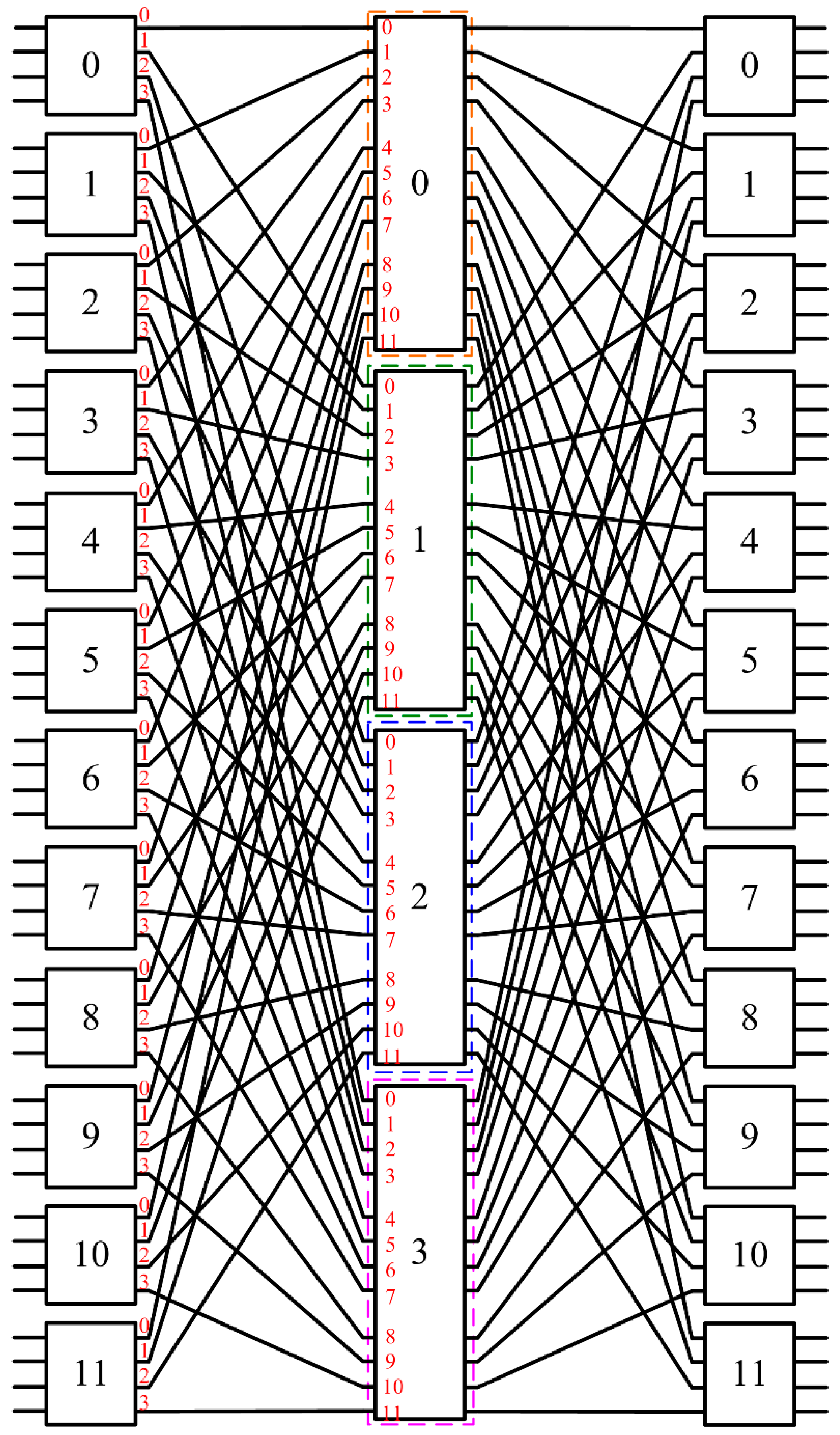
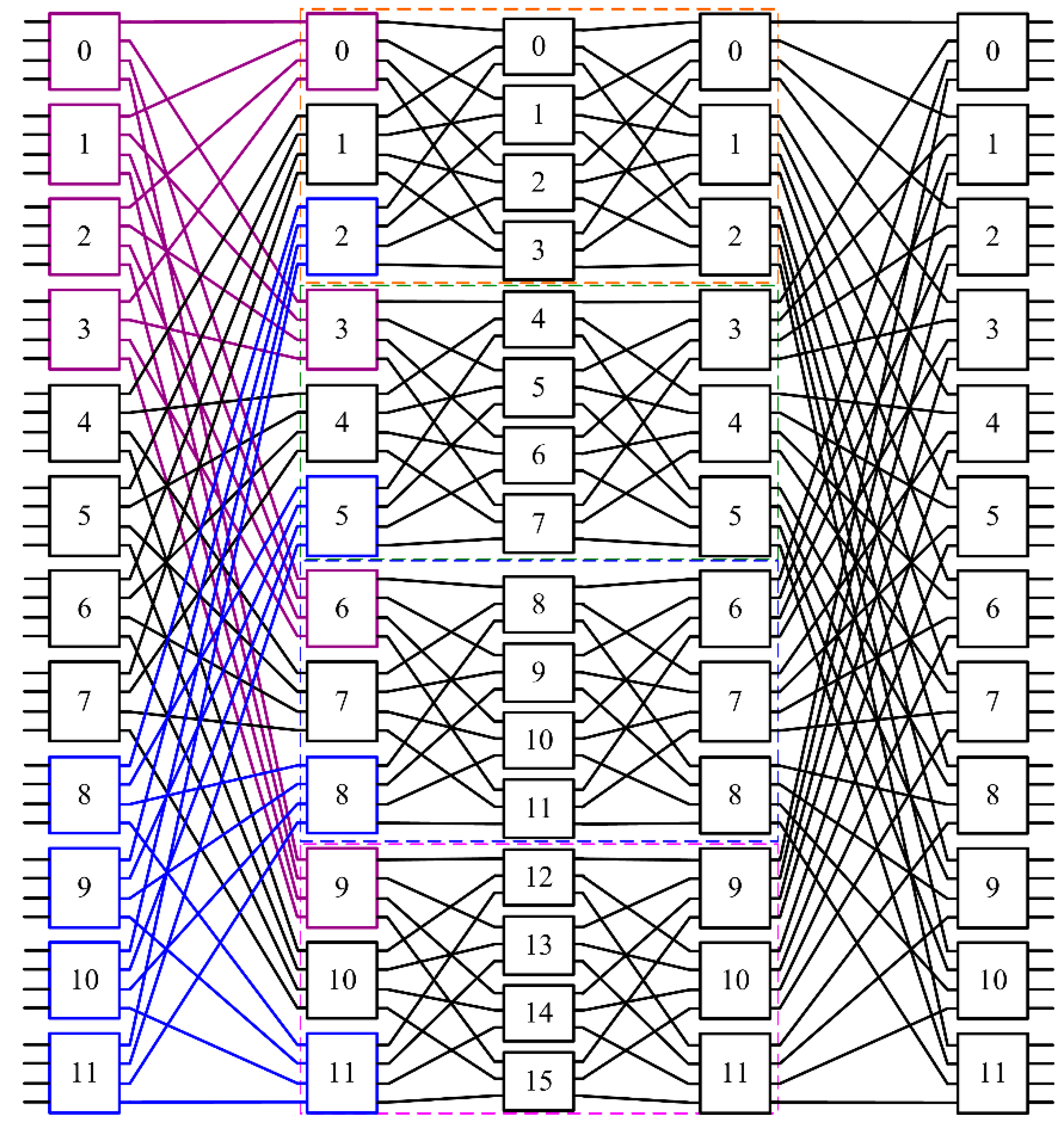
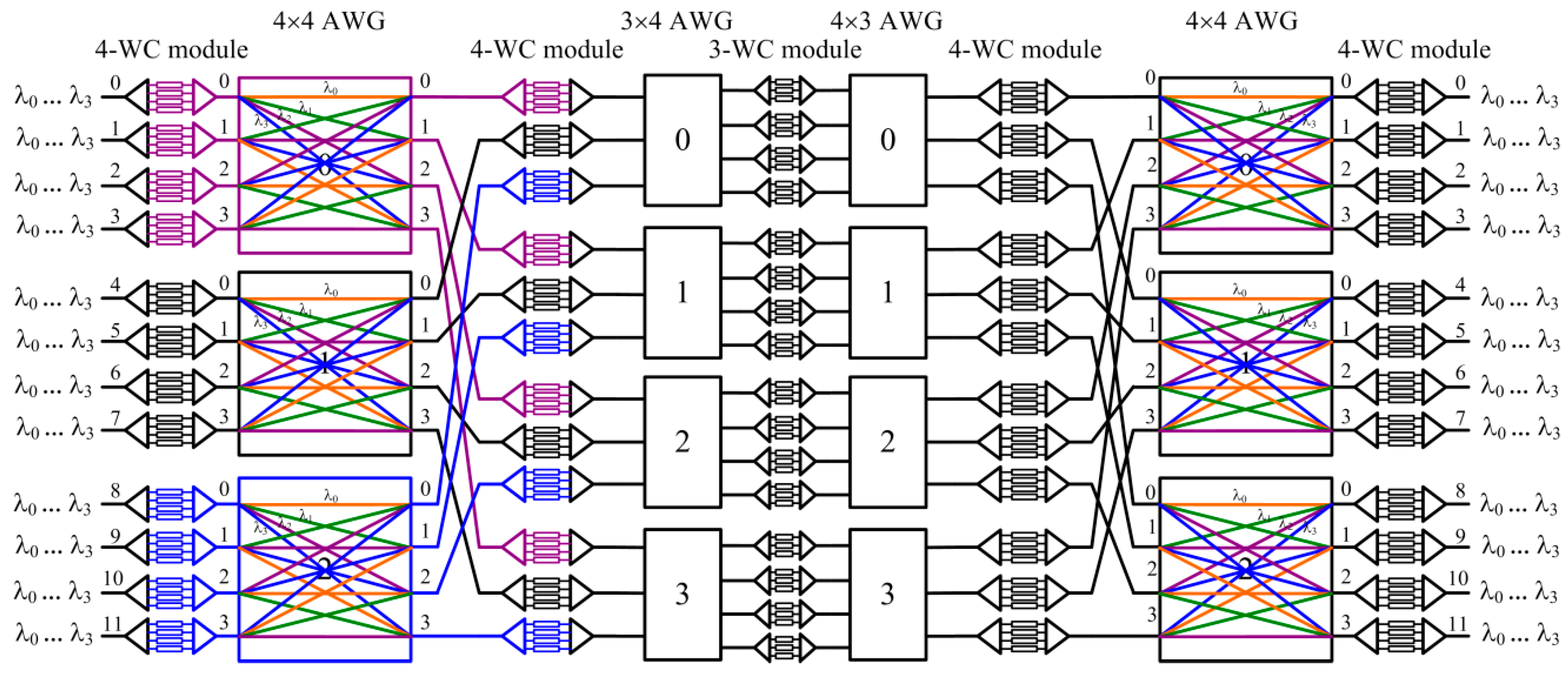
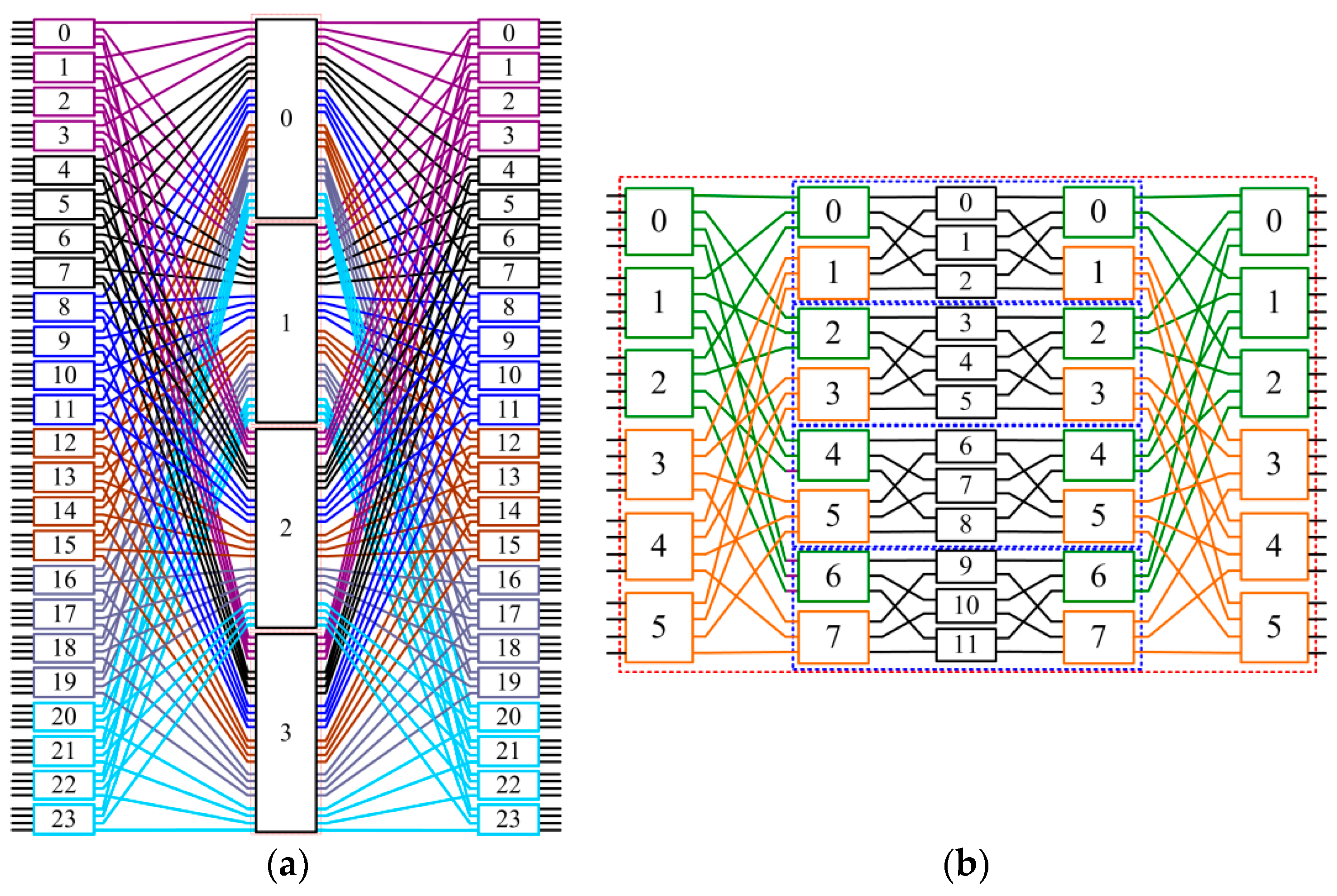
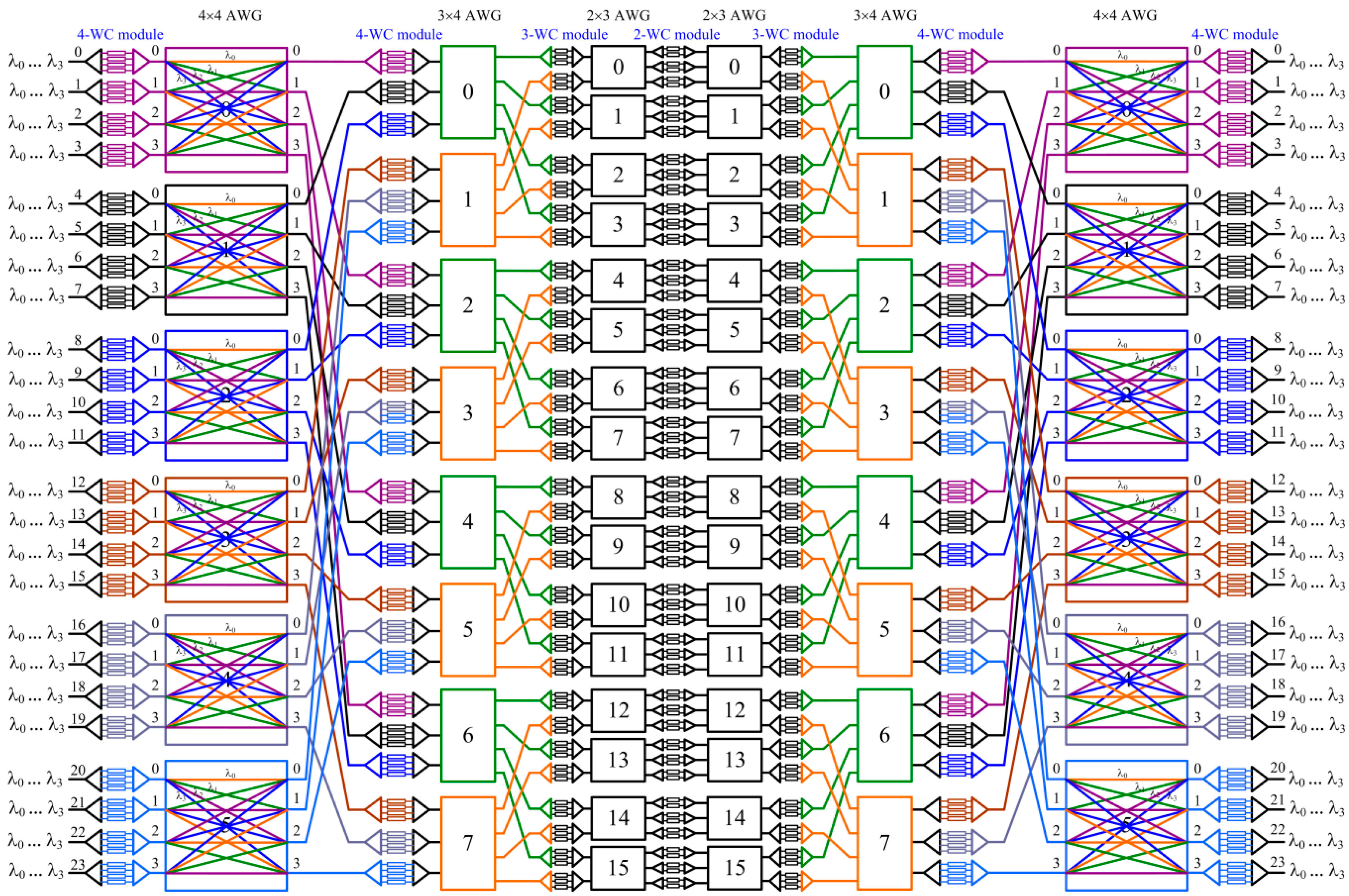
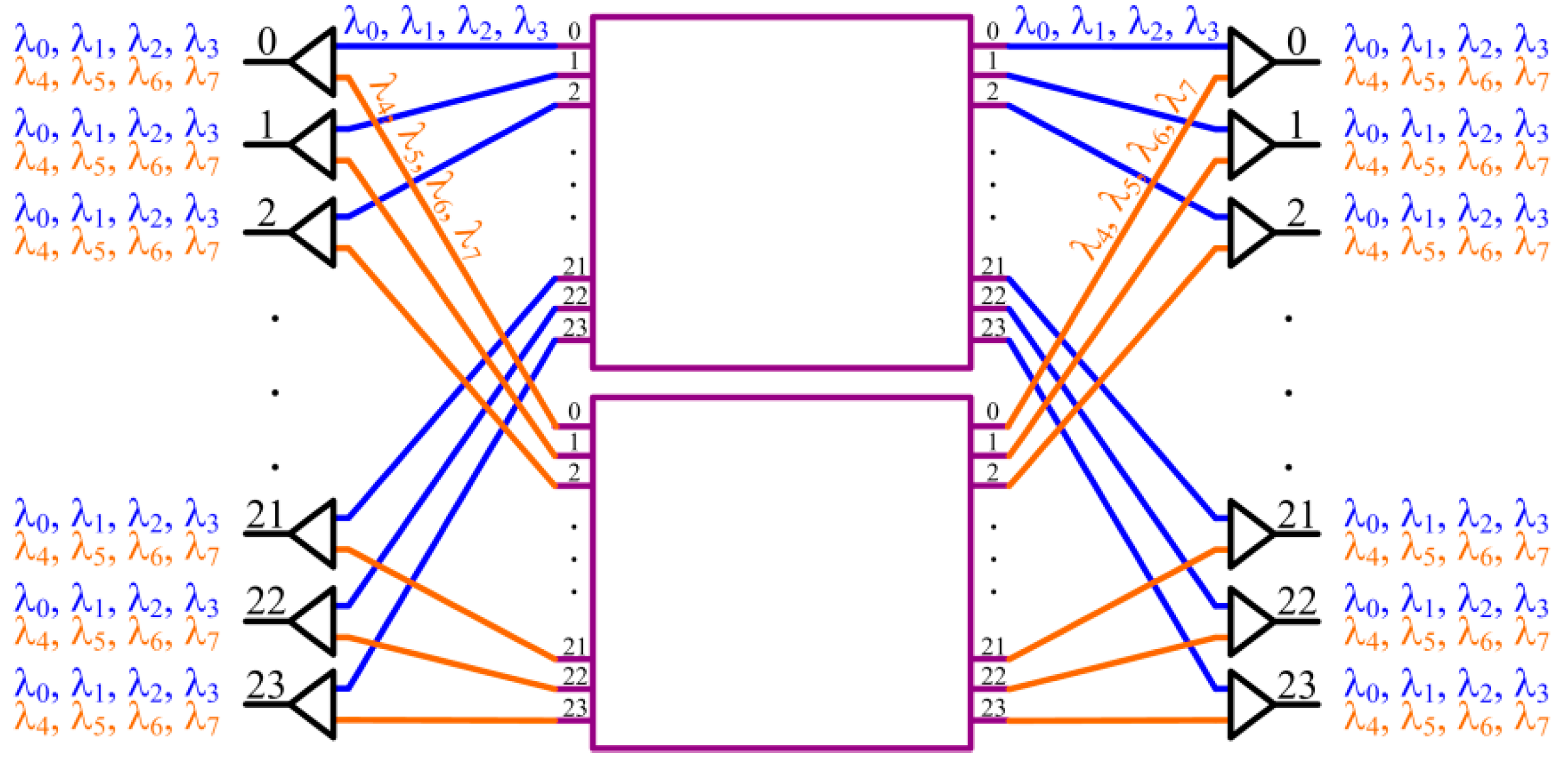

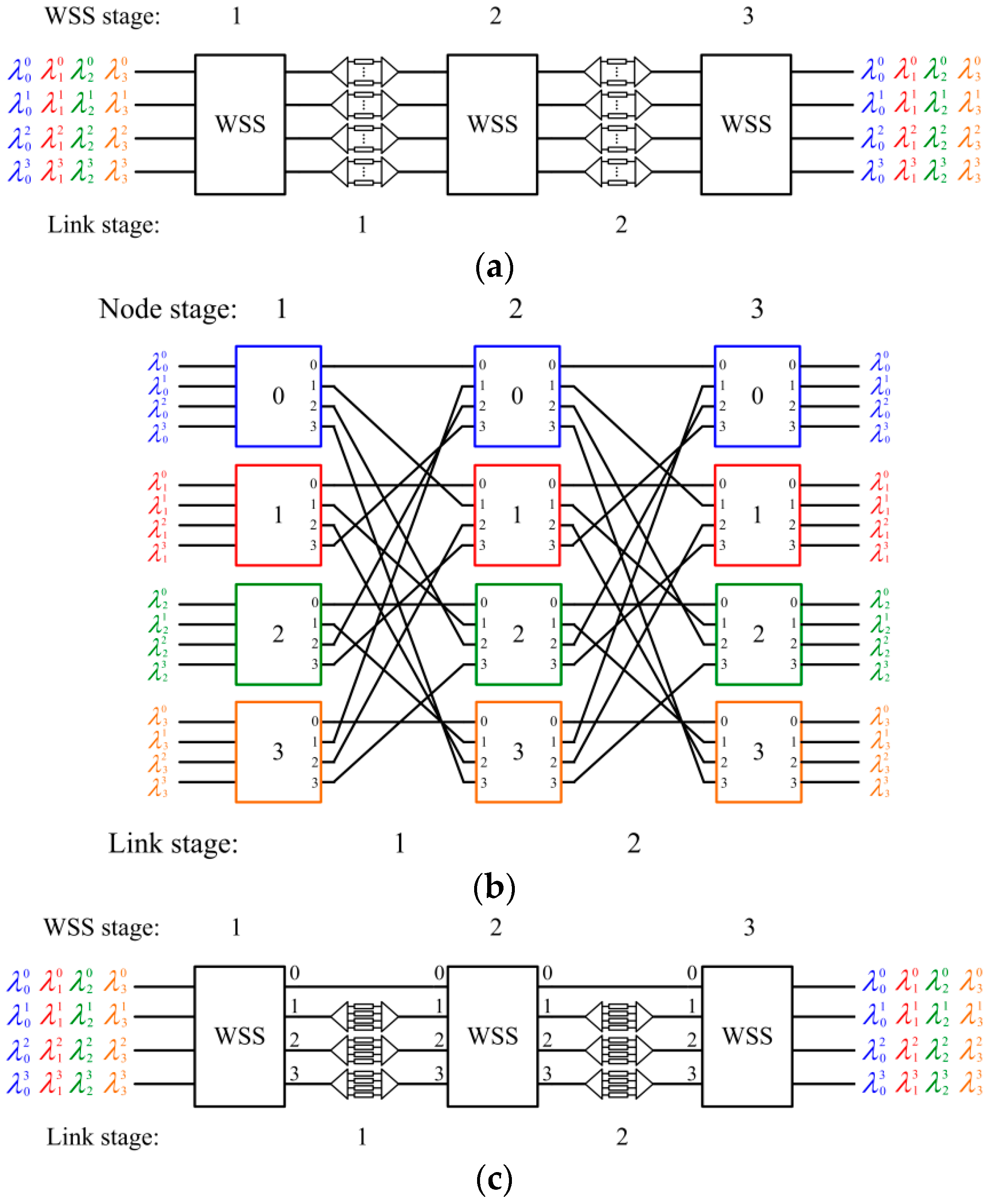

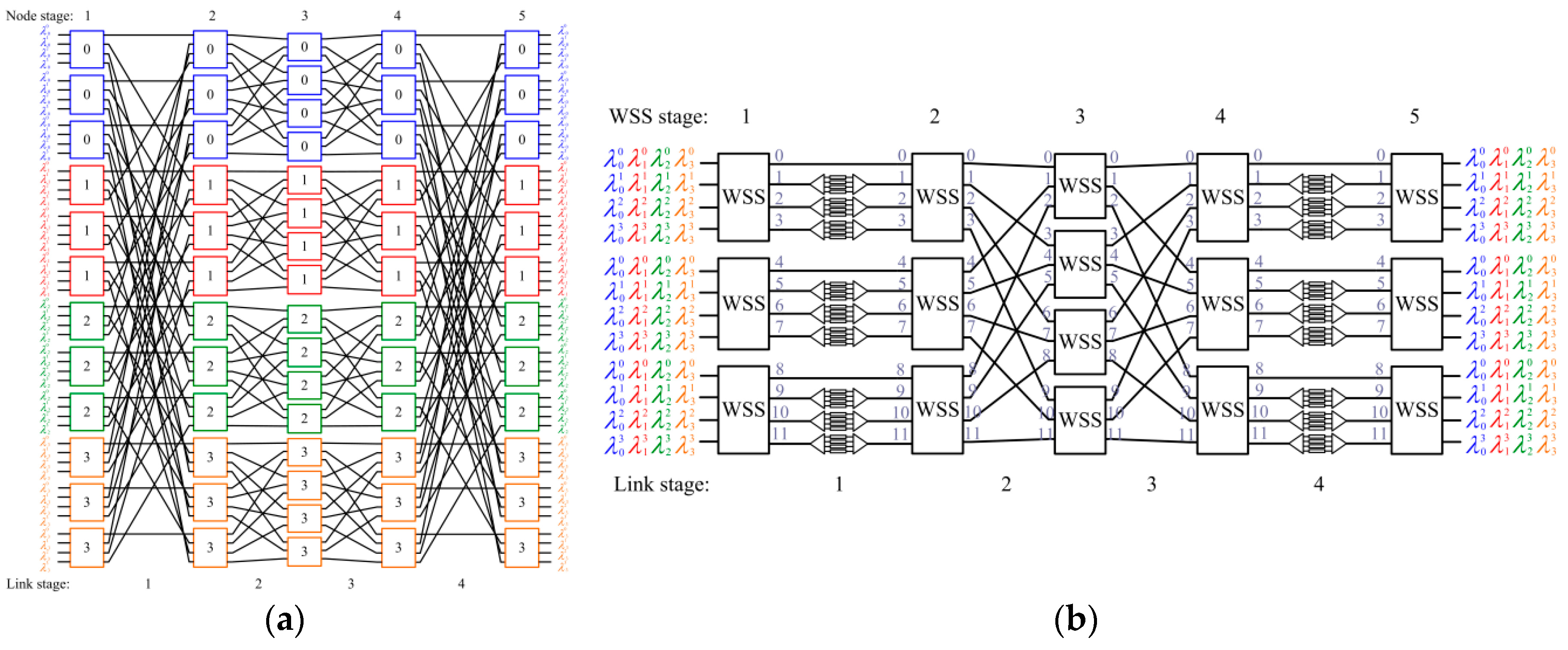
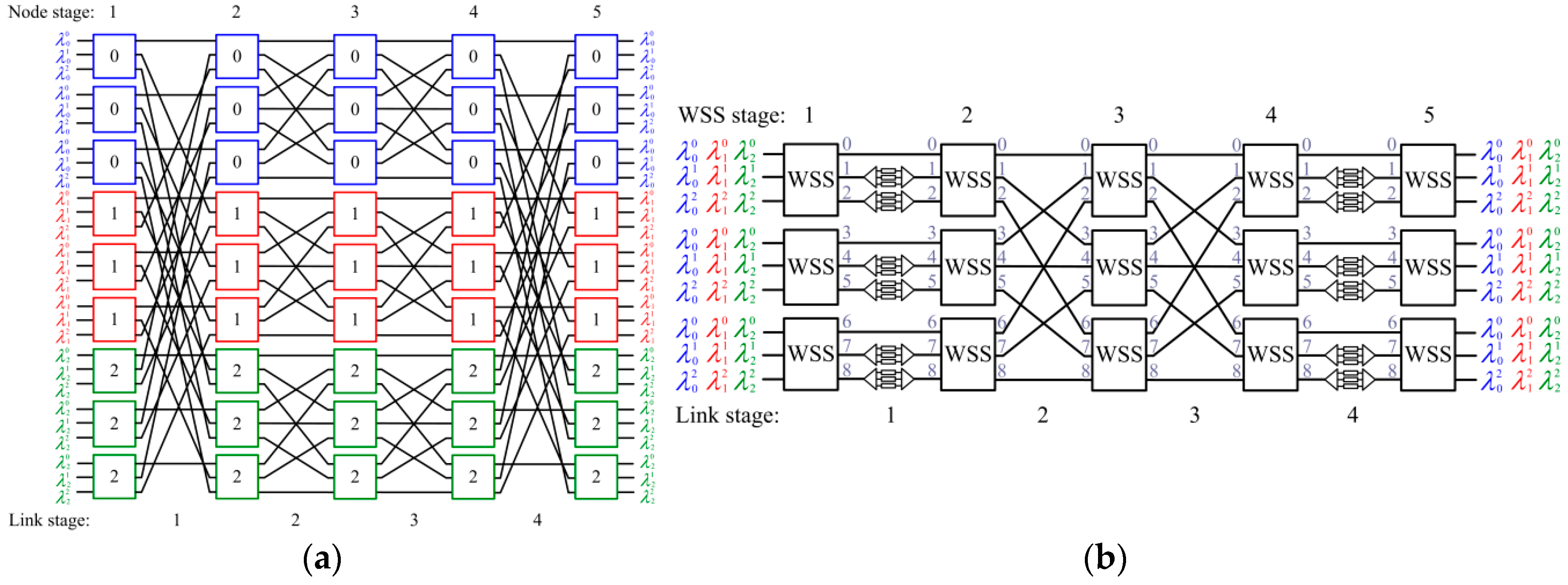
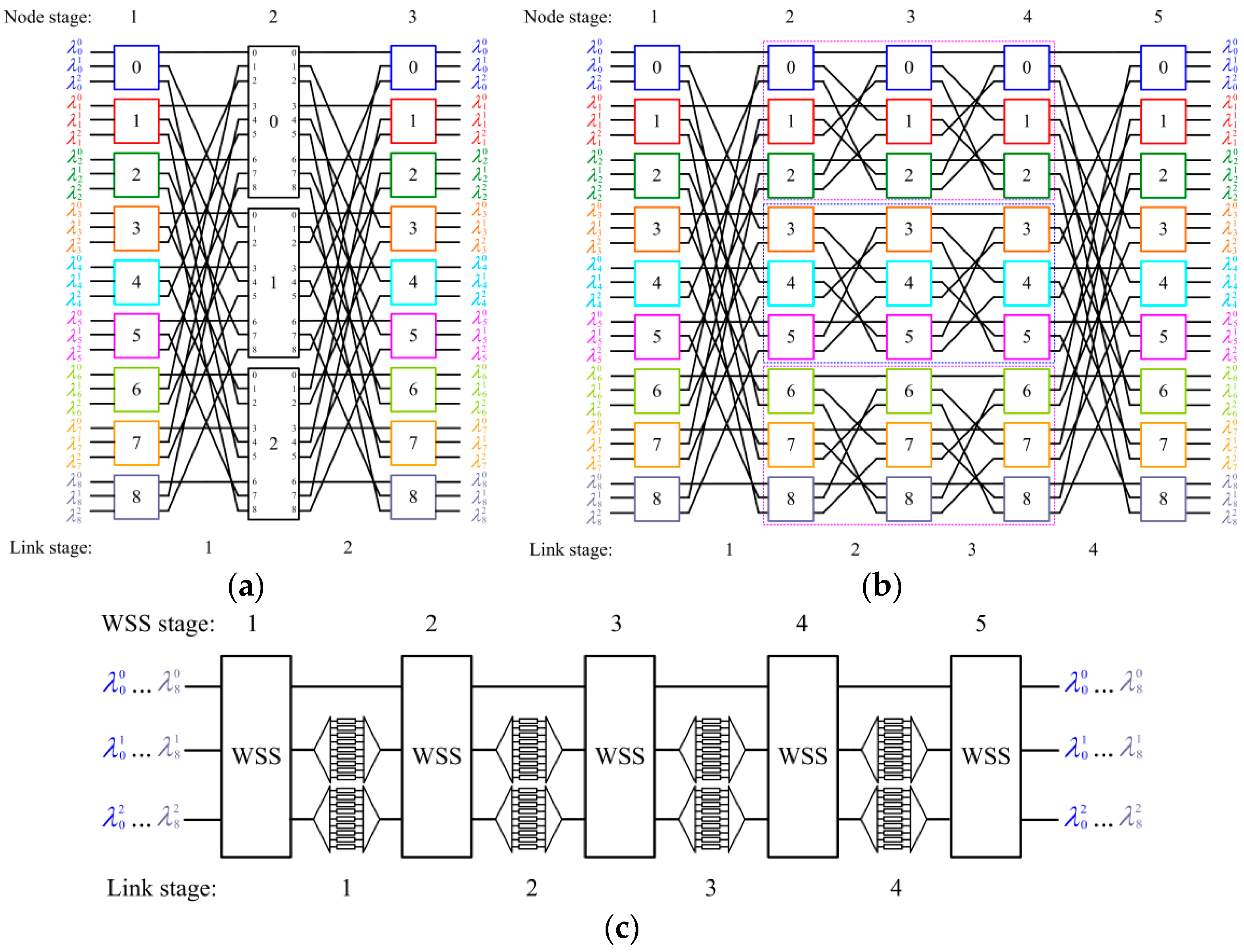
| n = 64, r = 64, N = 32 | AWG-Based Approach | WSS-Based Approach |
|---|---|---|
| Number of WCs | 24,576 | 8064 |
| Number of 32 × 32 AWGs | 8 | 0 |
| Number of 32 × 4 AWGs | 32 | 0 |
| Number of 4 × 32 AWGs | 32 | 0 |
| Number of 64 × 64 space switches | 0 | 192 |
| n = 64, r = 8, N = 32 | AWG-Based Approach | WSS-Based Approach |
|---|---|---|
| Number of WCs | 1536 | 1792 |
| Number of 16 × 32 AWGs | 1 | 0 |
| Number of 32 × 16 AWGs | 1 | 0 |
| Number of 8 × 8 space switches | 0 | 320 |
© 2017 by the authors. Licensee MDPI, Basel, Switzerland. This article is an open access article distributed under the terms and conditions of the Creative Commons Attribution (CC BY) license (http://creativecommons.org/licenses/by/4.0/).
Share and Cite
Lin, B.-C.; Lea, C.-T. Construction of Nonblocking Wavelength/Space Switches with AWGs and WSSes. Appl. Sci. 2017, 7, 555. https://doi.org/10.3390/app7060555
Lin B-C, Lea C-T. Construction of Nonblocking Wavelength/Space Switches with AWGs and WSSes. Applied Sciences. 2017; 7(6):555. https://doi.org/10.3390/app7060555
Chicago/Turabian StyleLin, Bey-Chi, and Chin-Tau Lea. 2017. "Construction of Nonblocking Wavelength/Space Switches with AWGs and WSSes" Applied Sciences 7, no. 6: 555. https://doi.org/10.3390/app7060555




